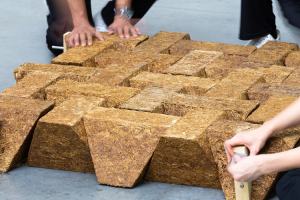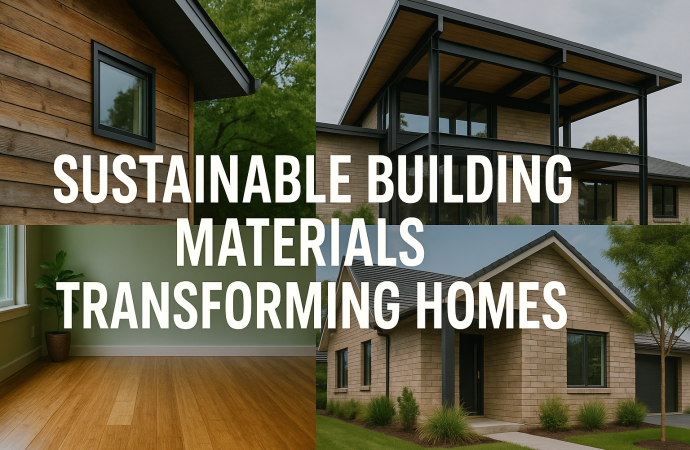Introduction Building a home is a big decision, and choosing the right materials is an important part of that process. More people are now looking for ways to make their homes more eco-friendly. One way to do this is by using sustainable building materials. These materials are better for the environment and can also make
Introduction
Building a home is a big decision, and choosing the right materials is an important part of that process. More people are now looking for ways to make their homes more eco-friendly. One way to do this is by using sustainable building materials. These materials are better for the environment and can also make your home more energy-efficient and healthier.
In this article, we will explore how sustainable building materials are transforming homes. We will look at the benefits of these materials and how they help protect the planet. Whether you are building a new home or remodeling your current one, understanding these materials will help you make better choices.
What Are Sustainable Building Materials?
Sustainable building materials are materials used in construction that have little or no impact on the environment. These materials are chosen for their ability to reduce waste, use renewable resources, and help save energy. The goal is to build homes that are not only strong and durable but also good for the planet.
There are many types of sustainable materials, including recycled products, renewable resources, and low-energy options. These materials are becoming more popular as people look for ways to live in a more eco-friendly way.
Why Are Sustainable Building Materials Important?

Image by: Yandex.com
Using sustainable materials helps reduce the negative impact of construction on the environment. Here are a few reasons why sustainable materials are important:
Save Energy
Sustainable materials can help reduce the amount of energy your home needs. For example, materials that provide better insulation will keep your home warmer in winter and cooler in summer, reducing the need for heating and air conditioning.
Lower Costs
While some sustainable materials may cost more upfront, they can save money in the long run. They can reduce your energy bills and the need for repairs or replacements over time.
Healthier Homes
Many sustainable materials are made without harmful chemicals. This helps create a healthier living space, free from toxins that can affect indoor air quality.
Protect the Environment
By using materials that are renewable or recycled, we reduce the need for new resources and reduce waste. This helps protect natural habitats and conserve resources for future generations.
Top Sustainable Building Materials

Image by: Yandex.com
Let’s take a look at some of the most popular and effective sustainable building materials used in homes today.
1. Bamboo
Bamboo is a fast-growing grass that is used as a building material. It is strong, durable, and easy to grow. Bamboo can be used for flooring, walls, furniture, and even structural supports.
- Why It’s Great: Bamboo grows quickly and can be harvested in just a few years, unlike trees that take decades to mature. It is also naturally resistant to pests and moisture, making it a great option for homes.
- Sustainability: Bamboo is a renewable resource because it grows so quickly. It can be harvested without damaging the environment.
2. Recycled Steel
Recycled steel is steel that has been reused from old buildings or products. It is strong, durable, and can be recycled again after use.
- Why It’s Great: Steel is one of the most recyclable materials in the world. It’s used for framing, roofing, and structural components of buildings. Recycled steel is just as strong as new steel, but using it reduces the need to mine for new materials.
- Sustainability: Using recycled steel reduces carbon emissions and the energy required to produce new steel, making it an eco-friendly choice.
3. Hempcrete
Hempcrete is a building material made from the hemp plant and lime. It’s a lightweight, insulating material that is used for walls and floors. Hempcrete provides excellent thermal insulation and helps regulate indoor temperatures.
- Why It’s Great: Hempcrete is a natural insulator and is resistant to mold and fire. It also helps create breathable buildings, which improve air quality inside your home.
- Sustainability: Hemp is a renewable resource that absorbs more CO2 than it emits while growing, making hempcrete a carbon-negative material.
4. Recycled Wood

Image by: Yandex.com
Recycled wood comes from old buildings, furniture, or other wood products. Instead of being thrown away, the wood is cleaned, restored, and reused for new construction projects.
- Why It’s Great: Recycled wood gives a unique look to homes and can be used for floors, walls, furniture, and more. It’s a great way to reduce waste and preserve natural forests.
- Sustainability: Using recycled wood reduces the need for cutting down new trees, helping preserve forests and reducing deforestation.
5. Cork
Cork is a renewable material harvested from the bark of cork oak trees. It is often used for flooring, wall coverings, and insulation. Cork is water-resistant, fire-resistant, and durable.
- Why It’s Great: Cork is comfortable to walk on, provides good insulation, and is naturally resistant to mold and mildew. It also offers a unique, natural look to interiors.
- Sustainability: Harvesting cork does not harm the tree. Cork oak trees continue to live and produce cork for many years, making cork a sustainable material.
6. Green Roofs and Walls
Green roofs and walls are covered with plants that help to insulate buildings, absorb rainwater, and improve air quality. These living surfaces are becoming more popular in urban areas.
- Why It’s Great: Green roofs and walls help reduce heating and cooling costs, improve air quality, and create green spaces in cities. They also provide a natural habitat for wildlife.
- Sustainability: Green roofs and walls help mitigate the urban heat island effect and reduce the environmental impact of buildings in cities.
7. Solar Panels
Solar panels are a renewable energy source that converts sunlight into electricity. They can be installed on rooftops to generate power for homes.
- Why It’s Great: Solar panels reduce the need for fossil fuels and can significantly lower electricity bills. They also have low maintenance costs after installation.
- Sustainability: Solar energy is renewable and clean, providing an eco-friendly alternative to traditional energy sources.
Table: Comparison of Sustainable Building Materials
| Material | Uses | Benefits | Sustainability |
|---|---|---|---|
| Bamboo | Flooring, furniture, structural elements | Strong, durable, fast-growing, moisture-resistant | Renewable, low environmental impact |
| Recycled Steel | Framing, roofing, structural components | Strong, fire-resistant, weather-resistant | Reduces carbon footprint, highly recyclable |
| Hempcrete | Insulation, walls, flooring | Excellent insulation, fire-resistant, breathable | Carbon-negative, sustainable crop |
| Recycled Wood | Flooring, paneling, furniture | Unique aesthetic, durable, reduces waste | Prevents deforestation, reduces production energy |
| Cork | Flooring, wall coverings, insulation | Comfortable, water-resistant, sound-absorbing | Renewable, biodegradable, recyclable |
| Green Roofs/ Walls | Roofs and walls covered in vegetation | Natural insulation, aesthetic, rainwater absorption | Reduces heat island effect, improves air quality |
| Solar Panels | Roofs, energy systems | Renewable energy, cost savings, low maintenance | Reduces carbon emissions, sustainable energy source |
Conclusion
Sustainable building materials are transforming the way we design and construct homes. From bamboo and recycled steel to hempcrete and solar panels, these materials offer many benefits, including energy savings, better indoor air quality, and a lower environmental impact. As the demand for greener buildings continues to rise, these materials will play a key role in shaping the future of construction.
By choosing sustainable building materials, you not only help protect the environment but also create healthier, more energy-efficient living spaces. Whether you are planning a new build or a renovation, incorporating sustainable materials can make a significant difference in the long-term performance and sustainability of your home.
Call-to-Action
Are you ready to build a more sustainable home? Start exploring sustainable building materials today and make your next project eco-friendly. Discover the benefits of using these materials and how they can help you create a greener, more efficient home for the future.
















